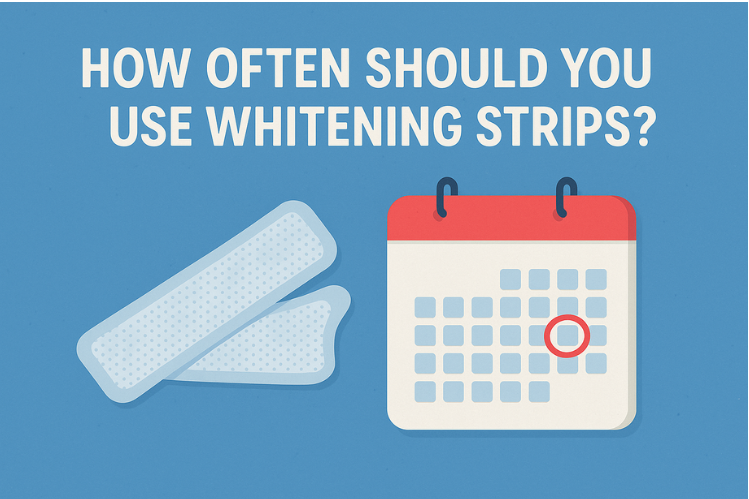
Ever stood in front of the mirror, whitening teeth strip in place, wondering if you’re overdoing it or not using it enough? You’re not alone. Whitening teeth strips are one of the easiest ways to brighten your smile at home, but here’s the tricky part: too much and you risk sensitivity, too little and you barely see results. So, how often should you actually use them?
That’s where most people get it wrong, and that is exactly what we’re going to clear up in this guide. Let’s get into the details so you know exactly where to draw the line.
What Are Whitening Teeth Strips

Whitening teeth strips are a popular and effective way to brighten your smile. They are thin, flexible strips coated with a whitening gel, which contains the active bleaching ingredient responsible for lightening the teeth. Peroxide-based teeth whitening strips are commonly used, and the hero components in these strips are usually hydrogen peroxide or carbamide peroxide.
How Do They Work?
Whitening teeth strips aren’t instant miracle patches that give you a Hollywood smile in seconds. When applied, the gel’s active ingredients get to work, breaking down stains on your tooth enamel.
Peroxide molecules seep into the enamel and chemically break apart deep-set stains through oxidation, leaving your teeth looking brighter. They contour to your teeth, which means the gel stays in contact for the right amount of time.
How Often to Use Whitening Strips Safely
Before starting to use a whitening teeth strip, it is important to know how often you should use a whitening strip in order to keep your teeth safe. Most dental professionals recommend using whitening strips once a day for a set period, usually 7 to 14 days, depending on the product instructions.
Stick to the schedule printed on the box. Whitening more frequently won’t speed up results. If you are aiming to maintain your results, occasional touch-ups every couple of months are fine, but don’t make them part of your daily routine forever.
Pro tip: Use ALIGNERCO Teeth Whitening Kit to get instant, safe and long-lasting results.
Why Enamel-Safe Whitening Strips Matter
Not all whitening strips are created equal. Enamel-safe whitening strips are designed to minimize irritation and protect your teeth’s outer layer while still lifting stains. Look for products that clearly state they are safe for enamel and approved by dental professionals.
Overuse Risks of Teeth Whitening Strips

Whitening strips can deliver impressive results, but overuse can backfire. Too much exposure to bleaching agents may:
- Increase tooth sensitivity to hot, cold, sweet, or acidic foods.
- Erode enamel permanently, making teeth more prone to decay.
- Irritate or burn gums if gel spills over repeatedly.
- Cause patchy results from uneven enamel or strip placement.
- In rare cases, overuse can cause inflammation of the tooth pulp, leading to pain..
To get your teeth whitened safely, you can use teeth whitening pens like those offered by ALIGNERCO to do instant touch-ups before any major event.
Choose the Best Whitening Teeth Strips for Sensitive Teeth
Here’s a straightforward guide to help you pick the right whitening teeth strips for sensitive teeth.
- Choose strips specifically marketed for sensitivity, as they usually have lower peroxide concentrations.
- Opt for products with hydrogen peroxide ≤6% or carbamide peroxide ≤18% for gentler whitening.
- Select strips that only need 5–10 minutes per day instead of 30–60 minutes to reduce irritation risk.
- Look for ADA (American Dental Association) approval or “enamel-safe” claims to ensure minimal damage.
- Opt for whitening strips that include desensitizing ingredients such as potassium nitrate or fluoride.
- Look for strips that mold snugly to your teeth to help avoid gel leakage onto gums.
- Read real user experiences to see if others with sensitivity tolerated the strips well.
- A quick check-up can ensure your teeth and gums are healthy enough for whitening.
Pro tip: Pair whitening strips with a sensitivity toothpaste during and after treatment to help calm your enamel.
Whitening Strip Usage for Long-Lasting Results
Getting results is one thing. Keeping them is another. Here’s how to extend that fresh, white look:
- Avoid coffee, tea, red wine, and other stain-causing foods for at least 48 hours following a whitening treatment.
- Use a straw when drinking colored beverages.
- Keep up with daily brushing and flossing.
- Schedule occasional touch-ups with enamel-safe whitening strips.
Your Teeth Whitening Routine Explained
At the end of the day, whitening teeth strips work, no question about it. But, stick to the schedule on the box. Don’t double up thinking you’ll get whiter teeth faster. You’ll end up with tooth sensitivity and irreversible enamel loss.
If you’ve got sensitive teeth, be picky. Low-peroxide, enamel-safe, ADA-approved options exist for a reason. Pair them with sensitivity toothpaste, and you’ll make it through your whitening cycle without wincing at every sip of coffee.
Honestly, if you want to speed things up or keep your smile photo-ready without overusing strips, it’s worth adding something like the ALIGNERCO Teeth Whitening Kit for at-home power whitening and our whitening pen for quick fixes. That way, you get the glow without the gamble.
FAQs
1. Do whitening teeth strips really work?
Whitening strips can brighten your smile, but results vary based on stain type, severity, oral health, and your teeth’s natural shade.
2. Can I brush my teeth after removing whitening strips?
Yes, you can brush after using whitening strips, but it’s best to wait at least 30 minutes.
3. What are the disadvantages of teeth whitening strips?
Whitening strips are convenient but can cause tooth sensitivity, gum irritation, and uneven whitening, especially on irregular teeth.
Citations:
Yetman, D. (2021a, February 4). Do teeth whitening strips work? Healthline. https://www.healthline.com/health/do-whitening-strips-work
Crest. (n.d.). How often should I use teeth whitening strips? - Crest. Crest. https://crest.com/en-us/oral-care-tips/teeth-whitening/how-often-should-i-use-teeth-whitening-strips/?srsltid=AfmBOopEsAF9S-fRj6Nlg8OYDKqdQ7c2WePXI9-eyw1TzeNTKxYtufzL








